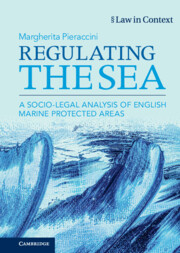Book contents
- Regulating the Sea
- Law in Context
- Regulating the Sea
- Copyright page
- Contents
- Preface and Acknowledgements
- Table of Cases
- Table of Legislation
- Abbreviations
- Introduction
- 1 The Geography of Regulation
- 2 Multi-level Regulation of English Marine Protected Areas
- 3 Impact Assessments for Marine Protected Areas
- 4 Risk-Based Regulation
- 5 Marine Conservation Zones Designation
- 6 Environmental Democracy in Marine Protected Areas Management
- 7 Climate Change and Marine Protected Areas Network
- 8 Marine Protected Areas Regulation in the Context of Regulatory Uncertainty and Change
- Concluding Remarks
- Bibliography
- Index
4 - Risk-Based Regulation
The Case of the Revised Approach to Fisheries in Marine Protected Areas
Published online by Cambridge University Press: 15 December 2022
- Regulating the Sea
- Law in Context
- Regulating the Sea
- Copyright page
- Contents
- Preface and Acknowledgements
- Table of Cases
- Table of Legislation
- Abbreviations
- Introduction
- 1 The Geography of Regulation
- 2 Multi-level Regulation of English Marine Protected Areas
- 3 Impact Assessments for Marine Protected Areas
- 4 Risk-Based Regulation
- 5 Marine Conservation Zones Designation
- 6 Environmental Democracy in Marine Protected Areas Management
- 7 Climate Change and Marine Protected Areas Network
- 8 Marine Protected Areas Regulation in the Context of Regulatory Uncertainty and Change
- Concluding Remarks
- Bibliography
- Index
Summary
This chapter discusses the development of risk-based approaches to regulating fisheries in marine protected areas. England has adopted a matrix that divides European Marine Sites into red, amber, green and blue based on the risk degree of gear/(sub)feature interactions. Applying the logic of risk-based regulation has meant that the enclosure of fisheries has been partial, and this is a welcome step towards a proportionate response, but it runs the risks of not being sufficiently precautionary to comply with the interpretation of article 6(3) of the Habitats Directive under retained case law. Besides, risk-based regulation is not without its critics and even in this case certain shortcomings are apparent. In reviewing the English revised approach, the chapter pays attention also to the actors involved and the knowledges accepted as evidence in developing and implementing the approach and in doing so it also taps into debates of commoning, asking whether the revised approach has facilitated collective problem-solving and epistemic inclusivity.
- Type
- Chapter
- Information
- Regulating the SeaA Socio-Legal Analysis of English Marine Protected Areas, pp. 74 - 93Publisher: Cambridge University PressPrint publication year: 2022

